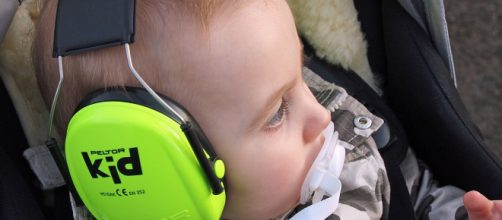A child’s hearing depends on proper eardrum vibration and the structures in the middle. Repeated infections can cause damage to the eardrum and fluid accumulation dampens eardrum vibrations leading to hearing problems. According to Medicine News Today the ears, nose, and throat are interconnected. If there is an infection in any of these parts it will affect both.
After the common cold, "Ear Infections are the second most commonly diagnosed illnesses in children," according to Baby Centre.com. Babies are more prone to ear infections because their Eustachian tubes are shorter and horizontal.
This makes it easier for germs and fluid to get trapped in the middle ear.
The space in the middle ear provides the perfect breeding ground for germs as it is dark and moist. As the infection worsens, the inflammation inside and behind the eardrum increases causing pain. The baby may also develop fever as their body tries to fight the infection.
Ear infections in babies can be hard to detect because they have not developed the language skills to express how they are feeling. Here are ways to spot an Ear Infection in babies before parents visit an emergency medical center.
Signs of an ear infection in babies
According to the Health Site.com, the symptoms include the following:
- Unpleasant smell from the child’s ear.
- Difficulty sleeping as lying down makes the ear infection more painful.
- Yellow or whitish fluid drains from the ear.
- Reduced appetite
- If the baby pulls at their ears.
- Running nose for the infection can result from a cold.
- Fever
- Redness behind the eardrum.
Treatment of an ear infection in babies
Most ear infections resolve on their own within a few days.
Whether a child takes antibiotics or not depends on their age and severity of their symptoms.
According to Pub Med Health, studies show that 1/3 of ear infections caused by bacteria usually improve on their own. Repeated doses of unwarranted antibiotics can lead to the development of resistant bacteria. This is why the watch-and-wait approach is recommended.
If the doctor prescribes antibiotics, the full course should be administered. A follow-up session is usually made a few weeks later to perform another ear examination.
Prevention of ear infections in babies
There is no foolproof plan to prevent the occurrence of ear infections in babies. According to greenhillspeds.com, it gives great tips on how to prevent ear infections.
However, there are steps parents can take to lower the odds of ending up in the emergency medical center.
- Breastfeed- this provides increased natural immunity.
- Bottle-feed in an upright position to prevent the milk from getting into the infection-prone areas of the ear.
- Limit using pacifiers to when the baby is falling asleep at night.
- Take precautions against allergies- keep pets and other allergens away from where your baby sleeps.
- Avoid second-hand smoke- cigarette smoke paralyzes the hairs that line the Eustachian tube, this prevents mucus from getting out of the middle ear space raising the risk for infections.
- Have the baby vaccinated- studies show that Prevnar, a vaccine that prevents pneumococcal bacteria helps reduce the number of babies who develop frequent ear infections.


